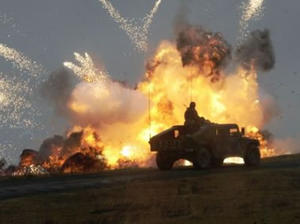Huge jump in IED attacks in Afghanistan
Monthly IED “incidents” in Afghanistan — incidents are defined as IEDs placed by insurgents and either found or detonated — from January 2004 to April 2010 has risen dramatically; data shows that an astounding jump in IED incidents occurred beginning summer 2009 — coinciding with the Marine offensive in the Helmand River Valley — and IED attacks have steadily mounted; there were more than 1,000 IED incidents during March, April, and May of this year; one expert says: data shows “that IEDs have become the equivalent of the Stinger [during the mujahedin war against the USSR in the 1980s] in allowing irregular forces to pose a major threat even to the most advanced military forces in the world”

The use of IEDs, packing hugely destructive power, increases in Afghanistan // Source: wired.com
A new, alarming report from the Pentagon’s Joint IED Defeat Organization (JIEDDO) offers a disturbing picture of intensified anti-U.S. IED campaign in Afghanistan. The report, which was provided to CSIS’s Anthony Cordesman (see his “Afghan and Iraqi Metrics and the IED Threat”), shows monthly IED “incidents,” defined as IEDs placed by insurgents and either found or detonated, in Afghanistan from January 2004 to April 2010.
Greg Grant writes in Defense Tech that the JIEDDO data shows that an astounding jump in IED incidents occurred beginning summer 2009 — coinciding with the Marine offensive in the Helmand River Valley — and IED attacks have steadily mounted. There were more than 1,000 IED incidents during March, April, and May of this year; nearly half of total incidents involved IEDs detonating. As the JIEDDO brief notes, a “significant number” of IEDs may have been emplaced but were never found or detonated.
The JIEDDO data shows “that IEDs have become the equivalent of the Stinger in allowing irregular forces to pose a major threat even to the most advanced military forces in the world,” Cordesman writes. The jump in insurgent IED attacks is alarming, but the data does show some good news: “the counter-IED effort has kept successful attacks far below the rate of increase in total attacks.”
Grant, referring to a chart labeled “Lethality of IEDs Over Time” included in Cordesman’s study, notes that the number of deaths per IED attack has “stabilized” at below 20 percent since April 2009. In March of this year, 434 IEDs detonated, resulting in 22 coalition troops killed and 252 wounded. In April, 475 IEDs detonated, resulting in 17 killed and 230 wounded. In May, 544 IEDs detonated, killing 34 coalition troops and wounding 250.
Coalition troops casualty rates from IED attacks approaching 300 per month is a grim statistic. Yet, it is a marked improvement over casualty rates per incident from summer 2009. During July 2009, 450 IEDs detonated, killing 49 and wounding 237 coalition troops. The next month, 554 IEDs detonated, killing 55 troops and wounding 333.
Grant writes that the lower casualty rate is likely due to the fact that the military has rushed large numbers of IED resistant vehicles to Afghanistan; another reason might be due to an increase in available medevac flights for wounded troops.
One bit of data that is not so good: the percentage of IEDs turned in by local Afghans has actually declined over time and is running at below 5 percent of total incidents. A 2009 report from the Center for New American Security (CNAS) identified the number of IEDs reported by local Afghans as an important metric of success:
“[A] a rise in the proportion of IEDs being found and defused (especially when discovered thanks to tips from the local population) indicates that locals have a good working relationship with local military units — a sign of progress. Conversely, a drop in the proportion of IEDs found and cleared indicates the population is not passing on information to security forces, and is standing by while they are attacked — a sign of deteriorating security.”
